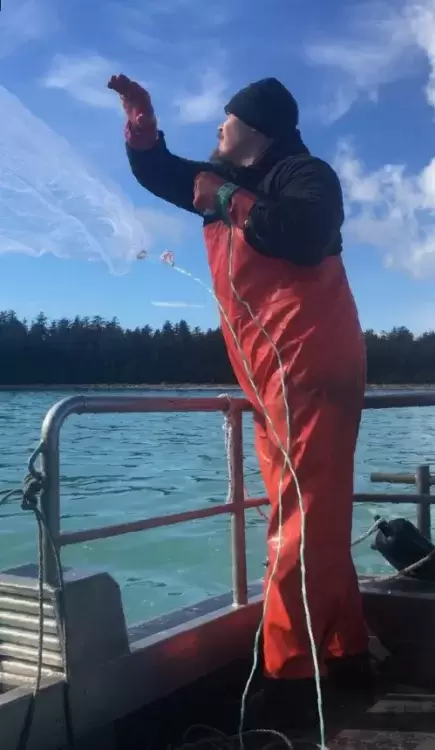Some herring spawns have been observed off Vargas and Flores Islands, as those who closely monitor the keystone species anticipate the bulk of reproduction to illuminate patches of the West Coast in March with aquamarine blue.
Fisheries and Oceans Canada’s test boats began collecting biological samples in Clayoquot and Nootka Sounds on Feb. 20 to gain information on the fish’s size, sex and age. In late February the Herring Spawn Reconnaissance Monitoring Program also took to the water, a DFO-funded initiative that supports boats from Nuu-chah-nulth nations that determine the depth and extent of areas where herring are spawning.
Besides airplane spawn surveys and dives conducted the previous year to gather data on eggs, the reconnaissance monitoring helps to inform the DFO’s models on the sustainability of the species and its ability to support harvests. This year the Nuchatlaht, Ehattesaht/Chinehkint, Mowachaht/Muchalaht, Hesquiaht and Toquaht First Nations have been funded to undertake the work on parts of Vancouver Island’s west coast.
The Nuu-chah-nulth monitoring involves casting nets in the water, explained Uu-a-thluk biologist Jim Lane.
“It’s not as precise as the dive surveys, but it’s information that is still very useful in the overall stock assessment process,” he said.
The west coast of Vancouver Island has not supported a commercial herring fishery since 2005, when seine and gill net boats caught a combined total of 4,245 short tons in Esperanza Inlet. The spawning biomass is forecast to be 24,171 tons this year, below the DFO’s limit reference point for a sustainable harvest. The Island’s west coast herring fishery will once again be closed for commercial harvesters, open only for small-scale First Nations food, social and ceremonial purposes.
“Low biomass and growth have persisted in most years since 2005, despite fishing closures during that time,” states the DFO’s 2019/20 Pacific Herring Integrated Fisheries Management Plan.
Besides a small-scale spawn-on-kelp fishery in the central coast, commercial closures are in place for the rest of the B.C. as well – except the Strait of Georgia. On the east side of Vancouver Island the spawning biomass is forecast to be 59,792 tons, less than the 122,000 predicted last year. In this region a harvest rate of 20 per cent of the spawning biomass is advised, up to a maximum of 11,960 tons.
While the forecast models are far from perfect, Lane has seen a growth in stocks since 2010.
“The overall trend is upwards, but it is sporadic,” he said.
Lane said that Nuu-chah-nulth leaders have not determined what a sustainable rate of harvest would be for the Island’s west coast.
“The nations have been pretty clear until there’s an agreed upon level of abundance that we’d open on, that they want the regular commercial herring fisheries remaining closed,” he said. “If you harvest 20 per cent for [west coast Vancouver Island] herring, you won’t meet your conservation objectives of being above that limit reference point with high probability, because it’s too aggressive for the productive state the herring are in right now.”
The current herring models that DFO uses neglect activity “at smaller special scales,” said Lane, while multiple questions on threats to the species linger.
“The overall productivity is less,” he explained. “What’s driving that? Is it increased natural mortality, which can be predation, or other things? Is it different ocean conditions where they’re not surviving as well just by food things? Or it a predator thing?”
As detailed in the DFO’s current management plan, by the early 1960s herring became a major fishery on the West Coast, when the annual commercial harvest had grown to over 200,000 tons. But overfishing caused the industry to collapse in 1967, which remained closed until 1973, although small fisheries continued for food and bait. Fueled by lucrative Japanese markets, the roe harvest began in 1971, which is currently the primary aim of commercial boats on the B.C. coast. This focuses on catching females when they are carrying the most eggs; the majority of the fish caught are fed to livestock or ground into feed for aquaculture.
Last year the Straight of Georgia’s roe fishery was open March 9-15 for seine boats, followed by gill nets that could harvest March 15-April 9. The seine fleet landed 7,178 tons, while gill nets caught 8,374 tons, a harvest that was below quotas set by the DFO.







